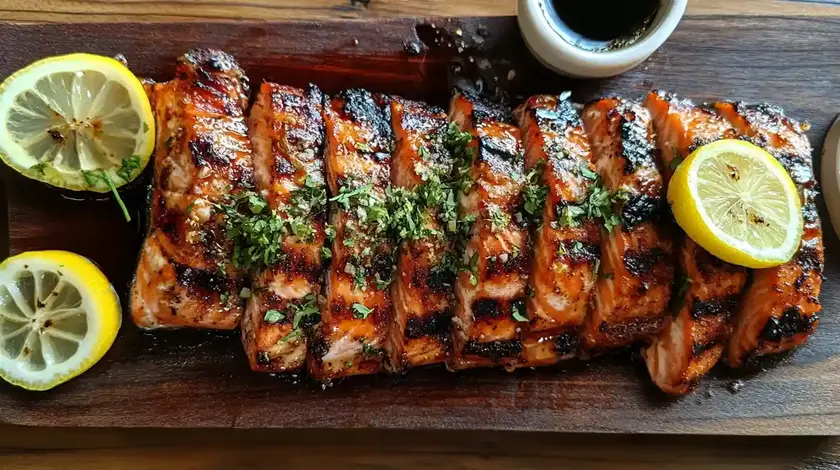Salmon belly is an underrated treasure of the seafood world. With its buttery texture, high omega-3 content, and deep, rich flavor, this cut of salmon is perfect for sushi, grilling, and pan-searing. Unlike leaner fillets, salmon belly offers higher fat content, which enhances both taste and nutritional value. Whether you’re looking for a protein-packed meal or simply want to enjoy a luxurious seafood experience, this cut is worth exploring.
For those who enjoy seafood variety, you might also be interested in exploring the health benefits of mixed seafood. Check out this article on whether frozen seafood mix is healthy to learn more about incorporating different seafood options into your diet.

Table of contents
What is Salmon Belly?
Salmon belly comes from the underside of the fish, running from the head to the tail. This cut is highly marbled with fat, making it much richer and softer than other parts of the salmon.
Why is Salmon Belly Special?
It is often considered the most prized cut of salmon, and for good reason. Unlike standard fillets, this rich, fatty section from the underside of the fish is packed with flavor, tenderness, and nutritional benefits that make it a top choice for chefs, food enthusiasts, and health-conscious eaters alike. Its unique texture, intense umami taste, and versatility in cooking set it apart from other seafood cuts.
1. Unmatched Flavor and Texture
One of the key reasons salmon belly stands out is its exceptionally high fat content, particularly omega-3 fatty acids. This gives it a buttery, melt-in-your-mouth texture that fillets simply cannot match. The delicate marbling of fat throughout the meat ensures that each bite is silky, juicy, and rich, making it a favorite for dishes like sashimi, grilled salmon, and pan-seared delicacies. When cooked, salmon belly retains its moisture, preventing it from becoming dry or tough something that often happens with leaner fish cuts.
Additionally, the fat marbling enhances the depth of flavor, making salmon belly one of the richest and most satisfying parts of the fish. Unlike milder salmon cuts, this one delivers a deep umami taste, with a subtle sweetness that pairs perfectly with a variety of seasonings and cooking methods. Whether it’s lightly salted and grilled, glazed with soy sauce, or served raw as sushi, salmon belly offers an indulgent experience in every bite.
2. Exceptional Nutritional Benefits
Beyond its incredible taste, it is a nutritional powerhouse. It is one of the best natural sources of omega-3 fatty acids, which are essential for heart health, brain function, and reducing inflammation. These healthy fats have been shown to lower cholesterol, improve circulation, and support overall cardiovascular health. Additionally, salmon belly is packed with high-quality protein, making it an excellent food choice for those looking to build muscle, repair tissues, and maintain a healthy metabolism.
Other key nutrients found in salmon belly include:
- Vitamin D – Supports immune function and promotes bone health.
- Vitamin B12 – Boosts energy levels and aids in brain function.
- Selenium – A powerful antioxidant that helps safeguard cells from damage.
- Potassium & Magnesium – Essential for muscle and nerve function.
Compared to other parts of the salmon, the belly offers higher concentrations of these essential nutrients, making it a top-tier choice for anyone looking to eat healthier while enjoying delicious food.
3. Versatility in Cooking
Another reason salmon belly is special is its versatility in the kitchen. Because of its fat content and soft texture, it adapts well to multiple cooking techniques, making it easy to prepare in countless ways. Some of the best ways to cook salmon belly include:
- Grilling – The high fat content keeps the fish juicy while adding a smoky char.
- Pan-Searing – Creates a crispy, golden-brown crust while keeping the inside tender.
- Broiling & Roasting – Quick cooking methods that enhance its natural oils and flavor.
- Sashimi & Sushi – Its smooth, buttery texture makes it perfect for raw dishes.
- Smoking & Curing – Enhances the fish’s rich taste with deep, complex flavors.
Unlike leaner cuts, it is more forgiving during cooking. The natural oils prevent it from drying out, even when exposed to high heat. It also pairs beautifully with simple seasonings, like sea salt, lemon, and garlic, as well as bolder flavors like teriyaki, miso, and chili.
4. A Rare and Coveted Cut
Unlike salmon fillets, which are widely available in supermarkets, it is considered a specialty cut. Because it comes from a small portion of the fish, it is harder to find and often more expensive. Many fish markets and high-end seafood restaurants value salmon belly for its premium quality and limited availability, making it a luxury seafood choice.
In many cultures, it is seen as a delicacy. In Japan, for example, it is highly prized in sushi restaurants and is often one of the most sought-after cuts for sashimi and nigiri. The perfect balance of fat and flavor makes it a standout dish, often compared to high-quality tuna belly (toro) in its richness and mouthfeel.
Best Ways to Cook Salmon Belly
Thanks to its high-fat content, it stays moist even at high temperatures. However, the right cooking method can enhance its natural richness.
1. Pan-Searing for Crispy Skin
Pan-searing salmon belly is one of the easiest and most delicious ways to enjoy it.
How to Pan-Sear Salmon Belly
- Step 1: Pat the salmon belly dry to remove moisture.
- Step 2: Heat a pan over medium-high heat and add a little oil.
- Step 3: Place the salmon belly skin-side down and press lightly to prevent curling.
- Step 4: Cook for 3-4 minutes, then flip and cook for another 1-2 minutes.
- Step 5: Season with salt, pepper, and lemon juice before serving.

2. Grilling for Smoky Flavor
Grilling salmon belly brings out a smoky aroma while keeping it juicy inside.
- Use a hot grill and lightly oil the grates to prevent sticking.
- Brush with soy sauce, honey, or miso glaze for extra depth.
- Cook for 2-3 minutes per side—overcooking will dry it out.
3. Sushi & Sashimi – Enjoying it Raw
Many sushi lovers seek out salmon belly for its silky texture. When eaten raw:
- Use sushi-grade salmon to ensure safety.
- Slice thinly for nigiri or sashimi.
- Pair with fresh wasabi and soy sauce to enhance its natural taste.
For more ideas on what to serve with salmon belly, check out these perfect side dishes.
Nutritional Benefits of Salmon Belly
Salmon belly is not just a delicious and flavorful cut of fish it is also a nutrient-dense powerhouse that offers a wide range of health benefits. Packed with essential fatty acids, high-quality protein, vitamins, and minerals, it is one of the healthiest seafood choices you can add to your diet. Unlike other cuts, salmon belly contains higher concentrations of omega-3s, making it a superfood for heart health, brain function, and overall well-being.
1. Rich Source of Omega-3 Fatty Acids
One of the biggest advantages of eating salmon belly is its high omega-3 fatty acid content. These healthy fats play a crucial role in maintaining heart health, reducing inflammation, and supporting brain function. Omega-3s, specifically EPA (eicosapentaenoic acid) and DHA (docosahexaenoic acid), are essential fatty acids that the body cannot produce on its own.
Health Benefits of Omega-3s in Salmon Belly:
- Supports Cardiovascular Health – Omega-3s help reduce bad cholesterol (LDL), lower blood pressure, and improve circulation. Regular consumption has been linked to a lower risk of heart disease and stroke.
- Boosts Brain Function – DHA is a key component of brain cells and helps improve memory, cognitive function, and mental clarity. It is also known to reduce the risk of Alzheimer’s disease and age-related cognitive decline.
- Reduces Inflammation – Omega-3s have anti-inflammatory properties that help with conditions like arthritis, joint pain, and autoimmune diseases. They also promote faster muscle recovery after exercise.
- Improves Eye Health – DHA is essential for maintaining healthy vision and may help prevent age-related macular degeneration.
- Supports Mood & Mental Health – Studies show that omega-3 fatty acids can help reduce anxiety, depression, and mood swings by promoting healthy brain chemistry.
Unlike many processed foods that contain unhealthy saturated fats, the omega-3 fats in salmon belly are considered some of the healthiest fats you can eat.
2. Excellent Source of High-Quality Protein
Protein is crucial for muscle growth, tissue repair, and overall body function. it is packed with lean, high-quality protein that provides all the essential amino acids needed for:
- Building and maintaining muscle mass
- Supporting cell regeneration and tissue repair
- Strengthening the immune system
- Boosting metabolism and weight management
Compared to red meat or processed protein sources, it offers a cleaner, leaner protein option with significantly less saturated fat and more heart-friendly nutrients.
3. Packed with Essential Vitamins and Minerals
Beyond healthy fats and protein, it is loaded with important vitamins and minerals that contribute to overall health and vitality.
Key Vitamins in Salmon Belly:
Vitamin D – Supports bone health, immune function, and calcium absorption. It also helps prevent osteoporosis and strengthens the body’s defense against infections.
Vitamin B12 – Essential for energy production, nerve function, and red blood cell formation. A lack of B12 can cause fatigue, weakness, and neurological issues.
Vitamin A – Important for eye health, skin regeneration, and immune support.

Key Minerals in Salmon Belly:
Selenium – A powerful antioxidant that helps reduce oxidative stress and support thyroid function. Selenium is also linked to lower cancer risk.
Magnesium – Helps regulate blood sugar, support muscle function, and reduce stress levels.
Potassium – Aids in fluid balance, heart function, and nerve signaling. Potassium also helps lower blood pressure and reduce the risk of strokes.
The combination of these vitamins and minerals makes it an excellent choice for boosting immunity, promoting longevity, and preventing nutrient deficiencies.
4. Supports Weight Loss & Metabolism
If you’re looking for a nutrient-dense food that can help with weight management, it is a great addition to your diet. The high protein content promotes satiety, meaning you feel fuller for longer, reducing the urge to snack on unhealthy foods. The healthy fats in salmon belly help regulate blood sugar levels and prevent sudden energy crashes that lead to cravings.
Additionally, omega-3 fatty acids have been shown to enhance fat metabolism, helping the body burn more calories efficiently. This makes it an excellent food choice for those following low-carb, keto, or paleo diets.
5. A Natural Anti-Aging Superfood
The high antioxidant content in it helps slow down the aging process by reducing oxidative stress and cellular damage. The combination of omega-3s, vitamins, and minerals works together to:
- Improve skin elasticity and hydration
- Reduce wrinkles and fine lines
- Promote stronger hair and nails
- Support joint health and flexibility
Regular consumption of salmon belly can help you maintain youthful skin, stronger bones, and overall vitality as you age.
6. Better Than Other Fish Cuts?
Compared to other parts of the salmon, the belly contains the highest concentration of omega-3s, healthy fats, and essential nutrients. While salmon fillets are leaner and milder, salmon belly offers more flavor, more tenderness, and more health benefits. The combination of rich, healthy fats and premium protein makes it one of the best cuts of seafood available.
How to Buy & Store Salmon Belly
Since it is not as commonly sold as fillets, finding fresh cuts can be tricky.
Where to Buy Salmon Belly
- Local fish markets – Best place to find high-quality cuts.
- Japanese grocery stores – Often carry it for sushi.
- Online seafood retailers – Some specialty stores deliver fresh seafood to your doorstep.
How to Store Salmon Belly
- Refrigeration: Use within 1-2 days for maximum freshness.
- Freezing: Wrap securely and store for up to three months.
- Thawing: Always defrost in the fridge overnight to prevent spoilage.

FAQs About Salmon Belly
1. Is Salmon Belly Healthier Than Fillets?
Yes! Salmon belly contains more omega-3 fatty acids, which are essential for brain and heart health.
2. Can You Eat Salmon Belly Raw?
Absolutely! Many sushi restaurants serve it as sashimi. Just make sure it’s sushi-grade and properly handled.
3. Does Salmon Belly Have Bones?
Some pieces may have small pin bones, but these can be easily removed with kitchen tweezers.
4. How Long Does it Last in the Fridge?
Fresh salmon belly should be consumed within 1-2 days. If you need to store it longer, freezing is recommended.
5. What’s the Best Way to Season Salmon Belly?
Simple is best! Try sea salt, black pepper, garlic, lemon, or soy sauce to enhance its natural taste.
Final Thoughts: Why You Should Try Salmon Belly
If you’ve never tried it, you’re missing out on one of the richest, most delicious cuts of fish. Not only is it packed with nutrients, but it’s also incredibly versatile in the kitchen. Whether you prefer it grilled, pan-seared, or raw, this omega-3-rich seafood will quickly become one of your favorites. Next time you’re at the market, keep an eye out for salmon belly your taste buds will thank you!

